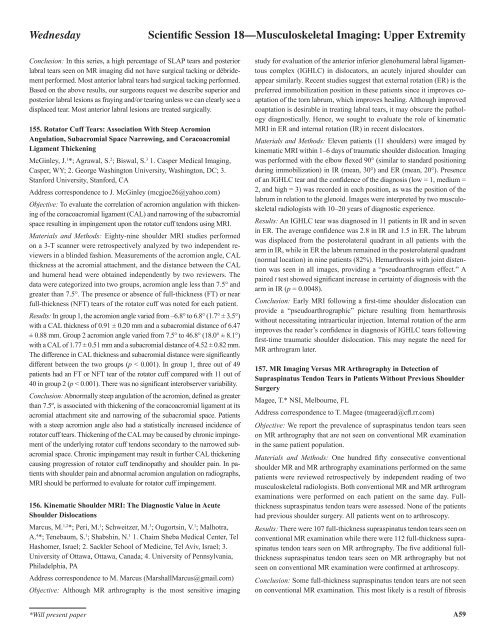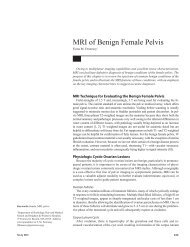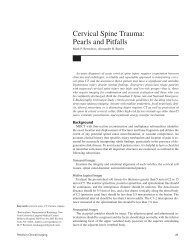Scientific Session 1 â Breast Imaging: Mammography
Scientific Session 1 â Breast Imaging: Mammography
Scientific Session 1 â Breast Imaging: Mammography
You also want an ePaper? Increase the reach of your titles
YUMPU automatically turns print PDFs into web optimized ePapers that Google loves.
Wednesday<strong>Scientific</strong> <strong>Session</strong> 18—Musculoskeletal <strong>Imaging</strong>: Upper ExtremityConclusion: In this series, a high percentage of SLAP tears and posteriorlabral tears seen on MR imaging did not have surgical tacking or débridementperformed. Most anterior labral tears had surgical tacking performed.Based on the above results, our surgeons request we describe superior andposterior labral lesions as fraying and/or tearing unless we can clearly see adisplaced tear. Most anterior labral lesions are treated surgically.155. Rotator Cuff Tears: Association With Steep AcromionAngulation, Subacromial Space Narrowing, and CoracoacromialLigament ThickeningMcGinley, J. 1 *; Agrawal, S. 2 ; Biswal, S. 3 1. Casper Medical <strong>Imaging</strong>,Casper, WY; 2. George Washington University, Washington, DC; 3.Stanford University, Stanford, CAAddress correspondence to J. McGinley (mcgjoe26@yahoo.com)Objective: To evaluate the correlation of acromion angulation with thickeningof the coracoacromial ligament (CAL) and narrowing of the subacromialspace resulting in impingement upon the rotator cuff tendons using MRI.Materials and Methods: Eighty-nine shoulder MRI studies performedon a 3-T scanner were retrospectively analyzed by two independent reviewersin a blinded fashion. Measurements of the acromion angle, CALthickness at the acromial attachment, and the distance between the CALand humeral head were obtained independently by two reviewers. Thedata were categorized into two groups, acromion angle less than 7.5° andgreater than 7.5°. The presence or absence of full-thickness (FT) or nearfull-thickness (NFT) tears of the rotator cuff was noted for each patient.Results: In group 1, the acromion angle varied from –6.8° to 6.8° (1.7° ± 3.5°)with a CAL thickness of 0.91 ± 0.20 mm and a subacromial distance of 6.47± 0.88 mm. Group 2 acromion angle varied from 7.5° to 46.8° (18.0° ± 8.1°)with a CAL of 1.77 ± 0.51 mm and a subacromial distance of 4.52 ± 0.82 mm.The difference in CAL thickness and subacromial distance were significantlydifferent between the two groups (p < 0.001). In group 1, three out of 49patients had an FT or NFT tear of the rotator cuff compared with 11 out of40 in group 2 (p < 0.001). There was no significant interobserver variability.Conclusion: Abnormally steep angulation of the acromion, defined as greaterthan 7.5º, is associated with thickening of the coracoacromial ligament at itsacromial attachment site and narrowing of the subacromial space. Patientswith a steep acromion angle also had a statistically increased incidence ofrotator cuff tears. Thickening of the CAL may be caused by chronic impingementof the underlying rotator cuff tendons secondary to the narrowed subacromialspace. Chronic impingement may result in further CAL thickeningcausing progression of rotator cuff tendinopathy and shoulder pain. In patientswith shoulder pain and abnormal acromion angulation on radiographs,MRI should be performed to evaluate for rotator cuff impingement.156. Kinematic Shoulder MRI: The Diagnostic Value in AcuteShoulder DislocationsMarcus, M. 1,2 *; Peri, M. 1 ; Schweitzer, M. 3 ; Ougortsin, V. 1 ; Malhotra,A. 4 *; Tenebaum, S. 1 ; Shabshin, N. 1 1. Chaim Sheba Medical Center, TelHashomer, Israel; 2. Sackler School of Medicine, Tel Aviv, Israel; 3.University of Ottawa, Ottawa, Canada; 4. University of Pennsylvania,Philadelphia, PAAddress correspondence to M. Marcus (MarshallMarcus@gmail.com)Objective: Although MR arthrography is the most sensitive imagingstudy for evaluation of the anterior inferior glenohumeral labral ligamentouscomplex (IGHLC) in dislocators, an acutely injured shoulder canappear similarly. Recent studies suggest that external rotation (ER) is thepreferred immobilization position in these patients since it improves coaptationof the torn labrum, which improves healing. Although improvedcoaptation is desirable in treating labral tears, it may obscure the pathologydiagnostically. Hence, we sought to evaluate the role of kinematicMRI in ER and internal rotation (IR) in recent dislocators.Materials and Methods: Eleven patients (11 shoulders) were imaged bykinematic MRI within 1–6 days of traumatic shoulder dislocation. <strong>Imaging</strong>was performed with the elbow flexed 90° (similar to standard positioningduring immobilization) in IR (mean, 30°) and ER (mean, 20°). Presenceof an IGHLC tear and the confidence of the diagnosis (low = 1, medium =2, and high = 3) was recorded in each position, as was the position of thelabrum in relation to the glenoid. Images were interpreted by two musculoskeletalradiologists with 10–20 years of diagnostic experience.Results: An IGHLC tear was diagnosed in 11 patients in IR and in sevenin ER. The average confidence was 2.8 in IR and 1.5 in ER. The labrumwas displaced from the posterolateral quadrant in all patients with thearm in IR, while in ER the labrum remained in the posterolateral quadrant(normal location) in nine patients (82%). Hemarthrosis with joint distentionwas seen in all images, providing a “pseudoarthrogram effect.” Apaired t test showed significant increase in certainty of diagnosis with thearm in IR (p = 0.0048).Conclusion: Early MRI following a first-time shoulder dislocation canprovide a “pseudoarthrographic” picture resulting from hemarthrosiswithout necessitating intraarticular injection. Internal rotation of the armimproves the reader’s confidence in diagnosis of IGHLC tears followingfirst-time traumatic shoulder dislocation. This may negate the need forMR arthrogram later.157. MR <strong>Imaging</strong> Versus MR Arthrography in Detection ofSupraspinatus Tendon Tears in Patients Without Previous ShoulderSurgeryMagee, T.* NSI, Melbourne, FLAddress correspondence to T. Magee (tmageerad@cfl.rr.com)Objective: We report the prevalence of supraspinatus tendon tears seenon MR arthrography that are not seen on conventional MR examinationin the same patient population.Materials and Methods: One hundred fifty consecutive conventionalshoulder MR and MR arthrography examinations performed on the samepatients were reviewed retrospectively by independent reading of twomusculoskeletal radiologists. Both conventional MR and MR arthrogramexaminations were performed on each patient on the same day. Fullthicknesssupraspinatus tendon tears were assessed. None of the patientshad previous shoulder surgery. All patients went on to arthroscopy.Results: There were 107 full-thickness supraspinatus tendon tears seen onconventional MR examination while there were 112 full-thickness supraspinatustendon tears seen on MR arthrography. The five additional fullthicknesssupraspinatus tendon tears seen on MR arthrography but notseen on conventional MR examination were confirmed at arthroscopy.Conclusion: Some full-thickness supraspinatus tendon tears are not seenon conventional MR examination. This most likely is a result of fibrosis*Will present paperA59
















